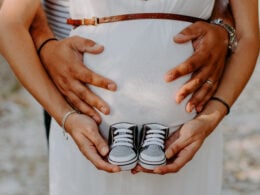Life changes after a miscarriage. I speak from experience: nearly seven years ago, I lost my second child to miscarriage, and every part of me changed. In the time since, with care for myself and love from my family and friends, I am in many ways stronger for having been so broken. But I wish that I had been charting my cycle during and after my loss, which allows a woman to better detect when ovulation after miscarriage will occur. This could have helped me to make better decisions about my health and fertility after the miscarriage, and given me more confidence about trying to conceive again once I recovered.
Many women who suffer miscarriage wonder what their experience means for charting. Most fertility awareness methods (or FAMs, also known Fertility Awareness-Based Methods or Natural Family Planning) do not include a specific protocol for charting after a miscarriage. However, FAMs offer a detailed understanding of the menstrual cycle, including the signs of ovulation, which can be applied to a post-miscarriage situation.
Your best option for figuring out how to chart through a miscarriage and for determining when you will ovulate again after a miscarriage, is to speak with your FAM or NFP instructor. Your instructor can also help you determine whether you are ready to try to conceive again based on your fertility charts. In some cases, as with repeat miscarriages, you may need to consult with an OB/GYN or a doctor trained in restorative reproductive medicine to investigate any possible underlying causes of miscarriage before trying to conceive again.
Reasons for a miscarriage can vary, but could include an error in the chromosomal make up of the embryo called aneuploidy. In this case, there is nothing you or a doctor could have done to save your baby. No matter what the reason or cause of your miscarriage, a helpful approach going forward is to take steps to improve your health and the health of the father. Working with a fertility awareness educator will help determine if you are having healthy ovulations and luteal phases, so that you will know when you can try to conceive again after a miscarriage.
What to expect during and after a miscarriage
A healthcare provider can offer the best guidance about what to expect in terms of miscarriage symptoms and recovery, depending on whether the miscarriage proceeded naturally or was performed surgically with a dilation and curettage (D&C). The stage of pregnancy before miscarriage would also have a bearing on what you experience.
It’s possible that miscarriage bleeding will occur for about two weeks and taper off before regular cycles resume. It’s also possible that bleeding will stop and then start again a variable number of days later, sometimes with accompanying cramping. In this situation, it’s likely due to a piece of the placenta that didn’t initially detach from the uterus. Your body may continue to produce pregnancy hormones (including human chorionic gonadotrophin, or hCG) to nourish this piece of the placenta, and you will not be able to conceive. Once the placenta has been fully separated, your body may flush it out, and that is why you may see stop-and-start bleeding. If you have bleeding or cramping beyond two weeks (or if other worrisome symptoms arise after a miscarriage, such as fever or foul-smelling vaginal discharge) alert your healthcare provider as soon as possible about the possibility of infection.
As you wait for your fertility to return after a miscarriage, understand that your hormones are undergoing a drastic shift, especially if the pregnancy was further along. If you chart your basal body temperature, you may find that it stays elevated during and immediately after the miscarriage, due to the initially higher levels of progesterone. Your doctor may also need to monitor your hCG levels to make sure they are going down as they should during and after a miscarriage. If your hormone levels aren’t returning to normal, your provider may do an ultrasound to examine the interior of the uterus, to make sure that no retained bits of placenta remain that may later cause infection and prevent your body from having a healthy conception later on. Because the cervix may still be somewhat open and more susceptible to pain and infection, it is also recommended that you abstain from sex and not use tampons during miscarriage bleeding.
When will I ovulate again after a miscarriage?
There isn’t a hard rule as to when you will ovulate after having a miscarriage, or when you will ovulate again after miscarriage bleeding stops. You could ovulate on your first post-miscarriage cycle, or it could take weeks for you to ovulate again. Your body is re-calibrating, and good nutrition and rest (as much as is possible as you grieve) will help. Often, the first cycle post-miscarriage is longer than average—because there is a delay in ovulation—or you may have a shorter luteal (post-ovulatory) phase, as your hormones return to their baseline.
Research shows that “that there is a lot of variability in the return of fertility” post-miscarriage, and “parameters of the menstrual cycle normalize quickly, i.e., by the second cycle” [1]. In layman’s terms, that means it’s tough to say how soon you’ll ovulate again after miscarriage, but once you do, it’s likely that your cycle will quickly return to its typical pattern. For example, when your fertility begins to return and you ovulate again, you’ll likely soon see the same patterns of basal body temperature and/or cervical mucus that you did before your miscarriage.
Charting after a miscarriage
Once the physical symptoms of your miscarriage have resolved and your cycle has returned, you may begin to chart again if you are ready. Different fertility awareness methods and NFP instructors may have differing recommendations for how to chart through a miscarriage. Some may recommend charting the first day of miscarriage bleeding as day 1 of a new cycle. Others may recommend that you keep using the same chart (counting the miscarriage as part of the previous cycle), since it is not menstruation.
No matter your fertility awareness method, it is recommended to abstain from sex until miscarriage bleeding has completely resolved, and some instructors (or your doctor) may recommend that you abstain longer based on the rules of your fertility awareness method and your goals for achieving or avoiding pregnancy (and then begin a new chart once menstruation occurs after that first post-miscarriage ovulation). It is highly recommended that you reach out to your FAM instructor at this time, because no matter your method, your instructor’s charting recommendations may change depending on different variables (e.g., how far along you were at the time of your pregnancy loss, if you were on progesterone, if you had a history of loss, if you were able to miscarry naturally or needed a D&C, and so on).
Trying to conceive after a miscarriage
Most healthcare providers recommend waiting two to four cycles before attempting to conceive again. Those who suggest waiting are looking to see that the pregnancy hormone hCG has returned to its regular level before conception occurs. This hormone is produced by the embryo after fertilization, and it’s what’s measured in home pregnancy tests. In theory, waiting for hCG to return to baseline elevates the chances of bringing a subsequent pregnancy to term. However, in practice, research shows no increased risk of loss when a woman conceives shortly after miscarriage [2]. If an otherwise healthy woman is ready to try again soon after an uncomplicated miscarriage, there is no medical evidence to deter her from that decision.
When you’re not ready to get pregnant again after a miscarriage
Every woman experiences miscarriage differently, and no one way of handling the loss is superior to another. Some couples need more time to process their grief, while others find that trying again helps to mend their broken hearts. While one study found ovulation occurred, on average, 50 days post-miscarriage, some of these women recorded ovulation after just 10 days [3]. Because of this, some FAMs typically recommend abstaining from intercourse until after the first menses, if the goal is to avoid pregnancy. But, if the method allows the identification of a temporary pattern of infertility, abstaining will not be necessary.
In this time, a woman will be looking out for signs of ovulation, as she did before, such as an increase in fertile mucus or a rise in basal body temperature. This could mean a longer period of abstinence than a couple is used to, so having other means of connecting, especially as emotions can be more challenging, is especially key to maintaining a healthy relationship after a miscarriage.
Practicing self-care during and after a miscarriage
Be gentle with yourself and try to be flexible with the difficult transition you’re experiencing. It is also important to allow yourself the time and grace to heal emotionally from your miscarriage; organizations like Life Perspectives can help you find healing resources online and in your local area. When grieving and healing from a miscarriage, it is more important than ever to practice authentic self-care.
Miscarriage is a challenging ordeal to experience physically, emotionally, and spiritually. With a trained instructor, fertility awareness methods and Natural Family Planning can help women to understand how their bodies are healing, and your method may be able to help you and your doctor to identify solutions to prevent future miscarriage. If you’re charting your cycle, a healthcare provider trained in restorative reproductive medicine techniques (such as NaProTECHNOLOGY) can help you analyze your charts and determine if a hormonal imbalance is a cause of miscarriage for you.
Life after a miscarriage will never be the same as it was before. What’s most important after miscarriage is that you have space and support to grieve in your own way, to find your path to healing.
References:
[1], [2], and [3] Fehring, R., 2017. Use of Fertility Awareness (NFP) After Early Pregnancy Loss. [online] FACTS. Available at: <https://www.factsaboutfertility.org/use-of-fertility-awareness-nfp-after-early-pregnancy-loss/> [Accessed 24 March 2021].If you have suffered a miscarriage, we are so sorry for your loss. For more resources on FAM and healing after miscarriage, check out the following articles:
Four Things Everyone Needs to Know About Miscarriage
Healing After the Loneliness and Heartbreak of a Miscarriage
How detecting the risk of miscarriage helped me become a mother
How fertility awareness reduces risk of miscarriage
When this article refers to fertility awareness methods (FAM), or natural family planning (NFP), we are referring to Fertility Awareness-Based Methods, evidence-based methods of cycle charting which can be used as effective forms of natural birth control when learned by a certified instructor.
This article was originally published on February 27, 2019 as written by Lindsay Schlegel. It has since been updated by Natural Womanhood to offer more resources. Last updated March 24, 2021.











